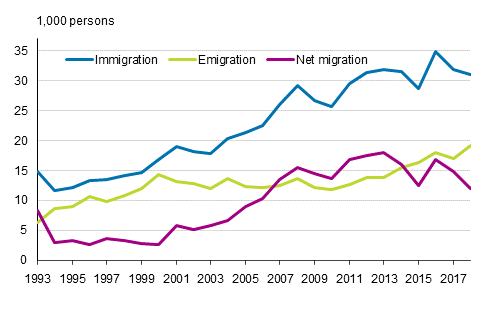Published: 17 June 2019
Net migration clearly lower in 2018 than in the year before
Corrected on 24 October 2019. The corrected numbers are indicated in red.
According to Statistics Finland, the migration gain for Finland in 2018 decreased clearly as it was 19 per cent lower than in 2017. The migration gain for Finland decreased to 11,958 persons from the previous year's 14,824. The reason for the lower migration gain was a decrease in immigration and an increase in emigration. In 2018, altogether 31,106 persons moved to Finland from abroad and 19,148 persons moved abroad from Finland.
Migration between Finland and other countries 1993–2018

The number of persons that moved to Finland from abroad decreased by 691 persons. Of immigrants, 23,146 or 74 per cent were foreign citizens in 2018. The emigration from Finland grew by 2,175 persons or 13 per cent than in the year before. Sixty per cent or 11,538 of emigrants were Finnish citizens. Finland's migration gain from foreign citizens amounted to 15,536 persons, but Finnish citizens generated a migration loss of 3,578 persons.
Immigration gain from immigrants from outside the EU
Finland's migration gain consisted almost completely of immigrants from outside the EU in 2018. However, immigration from other than EU countries decreased from the year before, while emigration to countries outside the EU was higher than in 2017. Net immigration from countries outside the EU declined to 12,733 from the previous year's 13,596.
The immigration gain was largest in Iraqi citizens, 1,797 immigrants and second largest in Russian citizens, 1,240 immigrants. Third most immigration gain to Finland came from persons of unknown citizenship, 750 immigrants.
More intermunicipal migrations and migrations within municipalities
In 2018, the number of intermunicipal migrations totalled 288,443, which was 604 more than in 2017. The number of migrations between regions was 136,400, with a decline of 284 migrations, while the number had grown with 3,454 migrations in 2017. Migrations between regions numbered 152,043, which was 888 more than one year earlier. In 2018, the number of intramunicipal migrations was 595,638, which was 3,587 higher than in 2017.
When looking at migration inside the country, the region of Uusimaa had the largest and the region of Pirkanmaa the second largest migration gain. In Uusimaa, the gain amounted to 6,896 and in Pirkanmaa to 2,621 persons. Migration gain relative to the population in Mainland Finland was largest in Pirkanmaa, where the migration gain was five per mil. The relative migration gain in Uusimaa was slightly lower than in Pirkanmaa.
The region having suffered the largest population loss in migration inside the country was South Savo, 1,543 persons. The relative migration loss was also largest in South Savo, nearly eleven per mil. The relative migration loss was the second largest in Kainuu. In intramunicipal migration, 15 regions suffered from migration loss.
Migration gain for regions from immigration
All regions received migration gain from international migration. Taking that into account, the number of regions with migration loss falls somewhat. The sum of net immigration and net emigration was negative in eleven regions. In Mainland Finland, net regional immigration was highest in Ostrobothnia and lowest in Kanta-Häme in relative terms.
Internal migration and in- and out-migration 2005–2018
| Year | Intermunicipal | Intramunicipal | Immigration | Emigration | Net migration |
| 2005 | 267 939 | 624 030 | 21 355 | 12 369 | 8 986 |
| 2006 | 265 469 | 600 097 | 22 451 | 12 107 | 10 344 |
| 2007 | 272 285 | 595 985 | 26 029 | 12 443 | 13 586 |
| 2008 | 262 454 | 567 619 | 29 114 | 13 657 | 15 457 |
| 2009 | 257 595 | 577 668 | 26 699 | 12 151 | 14 548 |
| 2010 | 264 362 | 575 323 | 25 636 | 11 905 | 13 731 |
| 2011 | 274 896 | 600 781 | 29 481 | 12 660 | 16 821 |
| 2012 | 274 650 | 595 163 | 31 278 | 13 845 | 17 433 |
| 2013 | 265 844 | 577 960 | 31 941 | 13 893 | 18 048 |
| 2014 | 267 799 | 571 775 | 31 507 | 15 486 | 16 021 |
| 2015 | 280 271 | 613 474 | 28 746 | 16 305 | 12 441 |
| 2016 | 282 257 | 590 830 | 34 905 | 18 082 | 16 823 |
| 2017 | 287 839 | 592 051 | 31 797 | 16 973 | 14 824 |
| 2018 | 288 443 | 595 638 | 31 106 | 19 148 | 11 958 |
Source: Migration 2018. Statistics Finland
Inquiries: Matti Saari 029 551 3401, Markus Rapo 029 551 3238, info@stat.fi
Director in charge: Jari Tarkoma
Publication in pdf-format (281.8 kB)
- Tables
-
Tables in databases
Pick the data you need into tables, view the data as graphs, or download the data for your use.
Appendix tables
- Figures
- Quality descriptions
-
- Quality description, migration 2018 (17.6.2019)
Updated 17.06.2019
Official Statistics of Finland (OSF):
Migration [e-publication].
ISSN=1797-6782. 2018. Helsinki: Statistics Finland [referred: 16.12.2025].
Access method: http://stat.fi/til/muutl/2018/muutl_2018_2019-06-17_tie_001_en.html

